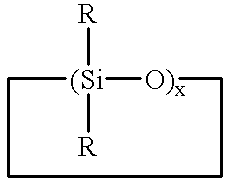Method for making polysiloxane emulsions
a polysiloxane and emulsion technology, applied in the field of polysiloxane emulsions, can solve the problems of inability to achieve a conversion inability to achieve a complete elimination of silicone oil layer, and inability to achieve a greater conversion rate of cyclicsiloxane into polysiloxane polymer, etc., to achieve a small
- Summary
- Abstract
- Description
- Claims
- Application Information
AI Technical Summary
Benefits of technology
Problems solved by technology
Method used
Image
Examples
example 1
This example illustrates a typical procedure of this invention wherein all of the surfactant is added at the beginning of the experiment.
354.9 grams of water, 95 grams of MAKON 10, 184 grams of ARQUAD T27W and 350 grams of cyclicsiloxanes having an average of 4 Si atoms per molecule, were added with stirring to a reaction flask and heated to 75.degree. C. 10 grams of 20% by weight sodium hydroxide was added to the mixture in the flask. The reaction was allowed to proceed for 2.5 hours with stirring before being neutralized with 5.8 grams of 85 percent concentrated phosphoric acid. The resulting product was an oil free, microemulsion with a 38 nanometer (nm) particle size. The conversion of monomer was 95% by weight. After 16 months at room temperature the microemulsion was still oil-free and had a particle size of 40 nm.
example 2
This example illustrates a typical method of this invention wherein all of the nonionic and part of the cationic surfactant is added at the beginning of the reaction and another part is added after catalysis.
354.9 grams of water, 95 grams of MAKON 10, and 350 grams of cyclicsiloxanes having an average of 4 Si atoms per molecule, were added to a reaction flask with stirring and heated to 65.degree. C. 150 grams of ARQUAD T27W and 10 grams of 20% by weight sodium hydroxide was added to the mixture in the flask. After the reaction had proceeded for 45 minutes an additional 34 grams of ARQUAD T27W was added to minimize the viscosity. The reaction was stopped after 2 hours and 45 minutes by neutralization with 5.8 grams of 85 percent concentrated phosphoric acid. An oil-free microemulsion with a particle size of 31 nm was formed. Percent conversion of monomer was not determined. After 17 months at room temperature the microemulsion was oil free and had a particle size of 30 nm.
example 3
This example illustrates the effect of the reaction temperature on the particle size.
The reaction was carried out by combining, with stirring, in a reaction flask 355 grams of water, 95 grams of MAKON 10, 140 grams of ARQUAD T27W and 350 grams cyclicsiloxanes having an average of 4 Si atoms per molecule. The contents in the flask were heated to the desired temperature (Table 1). 10 grams of 20% by weight sodium hydroxide was added to the mixture in the flask. The reaction was allowed to proceed until the monomer was consumed or the system was in equilibrium. The catalyst was neutralized by the addition of 5.8 grams of 85 percent concentrated phosphoric acid. In runs 3 and 4 an additional 44 grams of ARQUAD T27W was added in the latter part of the reaction to minimize viscosity. In run 5 only 34 grams of the ARQUAD T27W was added. Particle size and conversion results are given in Table 1. The microemulsions were all oil-free. After 16 months at room temperature, the microemulsions we...
PUM
| Property | Measurement | Unit |
|---|---|---|
| particle size | aaaaa | aaaaa |
| particle size | aaaaa | aaaaa |
| particle size | aaaaa | aaaaa |
Abstract
Description
Claims
Application Information
 Login to View More
Login to View More - R&D
- Intellectual Property
- Life Sciences
- Materials
- Tech Scout
- Unparalleled Data Quality
- Higher Quality Content
- 60% Fewer Hallucinations
Browse by: Latest US Patents, China's latest patents, Technical Efficacy Thesaurus, Application Domain, Technology Topic, Popular Technical Reports.
© 2025 PatSnap. All rights reserved.Legal|Privacy policy|Modern Slavery Act Transparency Statement|Sitemap|About US| Contact US: help@patsnap.com


